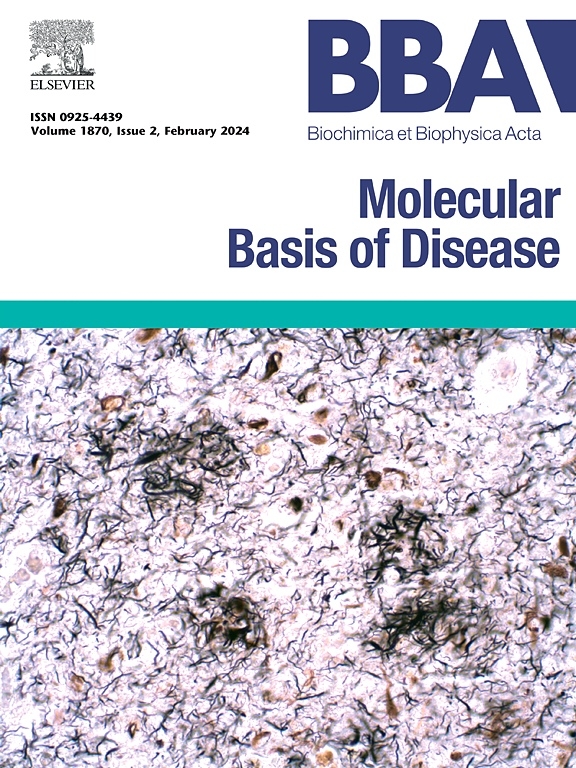遗传预测模型与高能饮食相结合构建食蟹猴2型糖尿病模型。
IF 4.2
2区 生物学
Q2 BIOCHEMISTRY & MOLECULAR BIOLOGY
Biochimica et biophysica acta. Molecular basis of disease
Pub Date : 2024-12-11
DOI:10.1016/j.bbadis.2024.167616
引用次数: 0
摘要
背景:2 型糖尿病(T2D)是一个重大的健康问题。非人灵长类动物患 T2D 的症状和胰腺变化与人类相似,因此利用非人灵长类动物进行研究至关重要,但受限于时间长和成功率低:结果:我们使用一个引物面板对 61 只正常和 81 只患有 T2D 的绒猴进行了目标捕获测序,该引物面板捕获了绒猴基因组中 269 个可能与 T2D 相关的潜在调控区域。确定了 80 个与 T2D 相关的变异,并将其用于构建遗传预测模型。在测试的 8 种机器学习算法中,我们发现使用带多项式核的支持向量机作为机器学习算法的模型预测效果最好(AUC = 0.933)。在该模型中加入年龄和性别并不能显著提高预测性能。利用基因预测模型,我们进一步筛选了 22 只猴子,发现其中 13 只为高风险猴,9 只为低风险猴。在用高能量食物喂养这 22 只猴子 32 周后,我们发现所有 9 只低风险猴子都没有患上 T2D,而 13 只高风险猴子中有 4 只(31%)患上了 T2D:结论:与传统方法相比,这种方法大大提高了建立 T2D 猴模型的成功率,同时减少了所需时间。因此,我们开发了一种结合遗传预测模型和高能量饮食建立T2D猴模型的高效率新方法,这将大大有助于临床特征、发病机制、并发症和潜在新疗法的研究。本文章由计算机程序翻译,如有差异,请以英文原文为准。
Construction of cynomolgus monkey type 2 diabetes models by combining genetic prediction model with high-energy diet
Background
Type 2 diabetes mellitus (T2D) is a significant health concern. Research using non-human primates, which develop T2D with similar symptoms and pancreatic changes as humans, is crucial but limited by long timelines and low success rates.
Results
We targeted capture sequenced 61 normal and 81 T2D cynomolgus monkeys using a primer panel that captured 269 potential regulatory regions potentially associated with T2D in the cynomolgus monkey genome. 80 variants were identified to be associated with T2D and were used to construct a genetic prediction model. Among 8 machine learning algorithms tested, we found that the best prediction performance was achieve when the model using support vector machine with polynomial kernel as the machine learning algorithm (AUC = 0.933). Including age and sex in this model did not significantly improve the prediction performance. Using the genetic prediction model, we further screened 22 monkeys and found 13 were high risk while 9 were low risk. After feeding the 22 monkeys with high-energy food for 32 weeks, we found all the 9 low risk monkeys did not develop T2D while 4 out of 13 high risk monkeys (31 %) develop T2D.
Conclusions
This method greatly increased the success rate of establishing T2D monkey models while decreased the time needed compared to traditional methods. Therefore, we developed a new high-efficiency method to establish T2D monkey models by combining the genetic prediction model and high-energy diet, which will greatly contribute to the research on the clinical characteristics, pathogenesis, complications and potential new treatments.
求助全文
通过发布文献求助,成功后即可免费获取论文全文。
去求助
来源期刊
CiteScore
12.30
自引率
0.00%
发文量
218
审稿时长
32 days
期刊介绍:
BBA Molecular Basis of Disease addresses the biochemistry and molecular genetics of disease processes and models of human disease. This journal covers aspects of aging, cancer, metabolic-, neurological-, and immunological-based disease. Manuscripts focused on using animal models to elucidate biochemical and mechanistic insight in each of these conditions, are particularly encouraged. Manuscripts should emphasize the underlying mechanisms of disease pathways and provide novel contributions to the understanding and/or treatment of these disorders. Highly descriptive and method development submissions may be declined without full review. The submission of uninvited reviews to BBA - Molecular Basis of Disease is strongly discouraged, and any such uninvited review should be accompanied by a coverletter outlining the compelling reasons why the review should be considered.

 求助内容:
求助内容: 应助结果提醒方式:
应助结果提醒方式:


